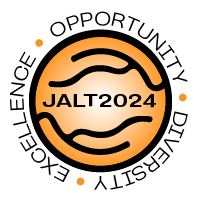19 January, 2020 - Rab Paterson
A Call To Apps: Current Best Practices in Digital Pedagogy
Rab Paterson
For our January 2020 session, Rab Paterson gave an overview of various apps that can be used to help students in the classroom. He presented a wide variety of apps that are relevant for different teaching situations.
Rab started with a comparison of current attitudes towards digital teaching tools between digital immigrants and digital natives. Digital natives are people who have grown up in the digital age and take apps for granted, while immigrants are those old enough to remember a time before the digital age.
He related to us a number of stories demonstrating how digital immigrant educators still have outdated views of how we can use technology. It's a problem especially in Japan. These teaching methods don't appeal to younger students today as they have higher expectations of how to learn. Children today enjoy the freedom to use apps for everything and as a result they can do self-study with all sorts of topics that suit their interests. Unfortunately digital integration is often missing from traditional teaching methods.
The next part of his presentation outlined some theories behind how we can assess and apply different learning apps.
One theory was the SAMR (Substitutes, Augments, Modifications and Redefinitions) Model. This model helps us decide on the best teaching tool to use by posing the following questions: Does the technology not just "substitute" but also "augments" traditional media? If so, then it will be worthwhile. Are there any "modifications" that also expand the activity? Then can we can use the app to "redefine" what the task encompasses and become more creative?
The final part of his presentation outlined a number of online learning tools and activities that could be useful for the classroom;
Here is a summary of some of the apps introduced:
- Wallet challenge - "A" asks probing questions of a partner "B" about their wallet. Then that person has to design a better wallet and present their idea by, for example, writing a blog post about it.
- Lextutor - You can copy and paste your work into this site and it analyses the amount and types of words that are used.
- Analyzemywriting.com - This site can give an assessment of the writing level of your students (eg. Grade 15 = student is writing at a level of a 21 year old). It can also turn their text into a cloze exercise.
- Paperrator - You can analyze and break down the types of grammar and words and give your text a score.
- Rewordify - You can simplify a text and make it more readable.
- Purdue Writing lab - This is a web site with lots of tips and hints on writing.
- Draftback - This app can show a student's progression on a document as well as how they are working on it.
- Likeso - This is an app that improves a teenager's vocabulary.
- Hofstede-insights.com - This quantitatively compares various categories of things.
- Feedly.com - This app allows a teacher to keep track of all student's blogs and the pro version allows you to do a key word search.
The complete list can be found at the following link: http://bit.ly/Rab2020JALT-Nankyu
Link to meeting listing

